Having commenced the week with International Women’s Day (Monday 8th March), Wine Lister’s latest blog celebrates some of the leading female figures in winemaking. Interviewing a handful of top producers across six regions, whose practices embody a range of principals, we put a spotlight on the wines made by some of the industry’s most exceptional women.
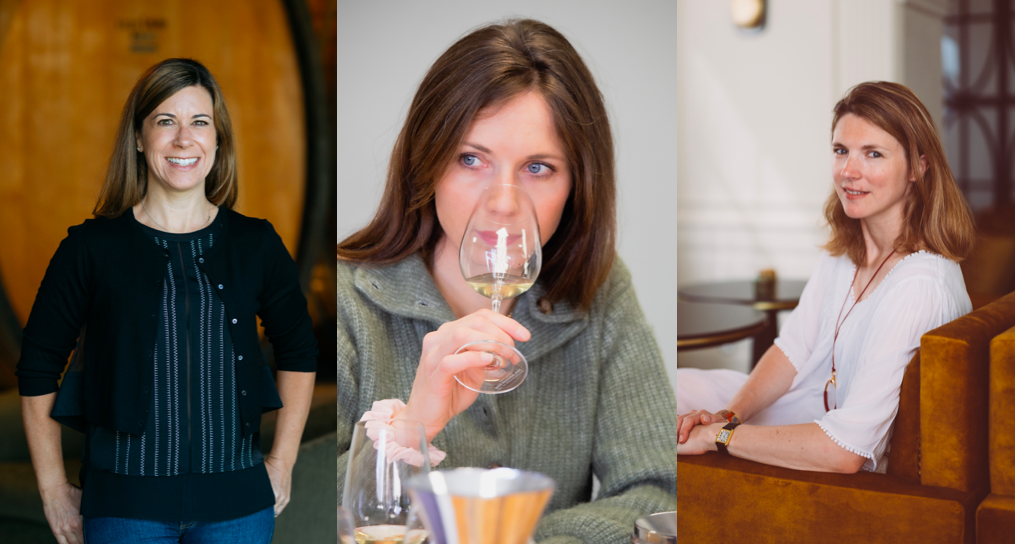 From left: Ashley Hepworth, Caroline Frey, and Stéphanie de Boüard-Rivoal
From left: Ashley Hepworth, Caroline Frey, and Stéphanie de Boüard-Rivoal
Ashley Hepworth – Joseph Phelps Vineyards
Following a degree in Chemistry and Biology, Ashley Hepworth spent two years cooking at Charlie Trotter’s legendary Chicago restaurant, where she realised she “wanted to learn more about wine and utilize [her] science background”. After studying the restaurant’s wines, and quizzing its Master Sommeliers, she applied for a harvest internship at Joseph Phelps where she continued to work her way “up the ladder”, eventually becoming winemaker in 2008. She is “particularly fond” of the 2008, 2015, and 2017 vintages of Joseph Phelps’ flagship wine, Insignia, explaining that each are “distinctive of the given vintage and the interplay of the six estate vineyards” that the wine is blended from.
Caroline Frey – La Lagune and Paul Jaboulet Aîné
Having taken the helm of third-growth property La Lagune from her father in 2004, Caroline Frey has since assumed an additional winemaking role in the Rhône, at Paul Jaboulet Aîné, after its acquisition by her family in 2005. Like several of the producers we spoke to, Caroline informs us that working “in harmony with nature is a long-term project” for her, with both properties now certified biodynamic. She explains that “to produce great wine the grapes must be the fruit of nature and not of synthetic chemistry”, and the more she “improves in working in harmony with nature” the “more wonderful” her wine will be.
Stéphanie de Boüard-Rivoal – Angélus
Having spent her childhood at Angélus, Stéphanie de Boüard-Rivoal was seven years old when she told her grandfather, Jacques de Boüard de Laforest, that she wanted to join him and her father, Hubert, in running the estate. After an early career in London’s financial sector, Stéphanie returned to Angélus in 2012, and has since continued a “quest for excellence while endeavouring to keep the estate in [her] family”. Noting “purity, tension, and focus” as key words to describe the style of her wine, she tells us that she is currently fond of Angélus’ 2005 and 2010 vintages, and anticipates enjoyment of the 2016 and 2018 in the coming years.
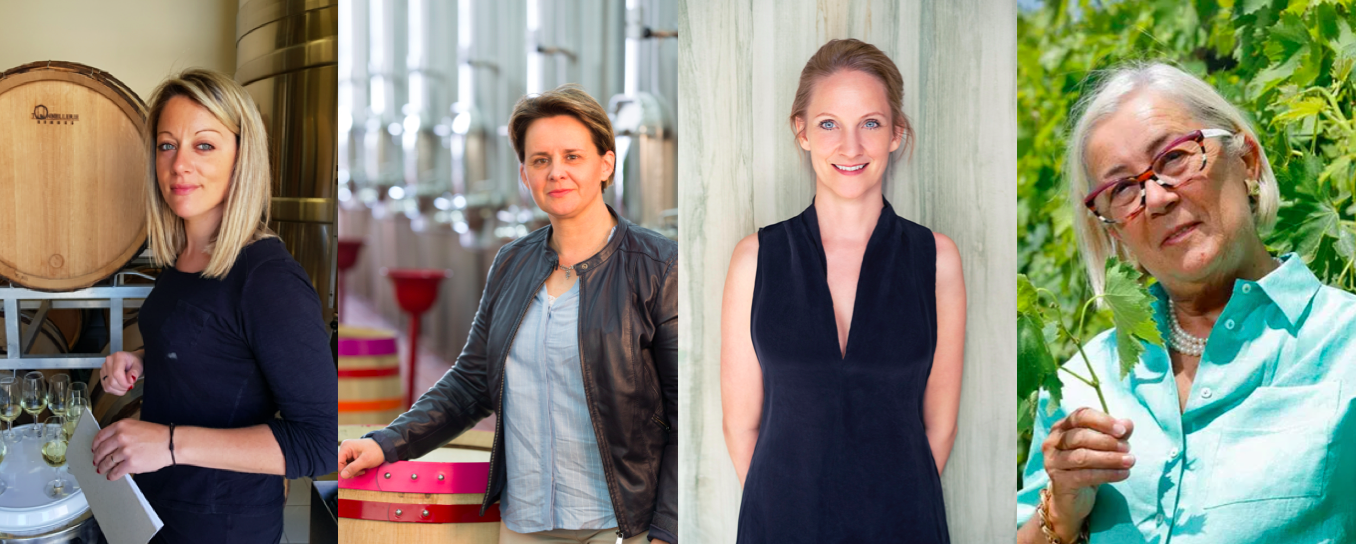 From left: Charlène Pinson, Florence Heresztyn-Mazzini, Eva Fricke, and Donatella Cinelli Colombini
From left: Charlène Pinson, Florence Heresztyn-Mazzini, Eva Fricke, and Donatella Cinelli Colombini
Charlène Pinson – Pinson
One of the longest-established families in Chablis, records show that the Pinsons have been producing in the region since 1640. Having joined her father, Laurent, at the estate in 2008, Charlène Pinson tells us of her respect for tradition and the work that her family has done before her, with the aim to “pass on the passion” to her two sons. Producing 13 different wines, she explains that each is a “reflection of their terroirs”, and are “more or less floral and fruity” depending on the slope and soil of the parcel. For those new to Pinson, she recommends the 2017 Chablis Mont de Milieu, describing it as a “pure expression of our Kimmeridgian limestones […] classic, mineral, balanced, and fresh”.
Florence Heresztyn-Mazzini – Heresztyn-Mazzini
Taking over her family’s estate (Domaine Heresztyn) in 2012, Florence Heresztyn-Mazzini and her husband, Simon Mazzini have overseen numerous developments under its new name. Introducing biodynamic practices in 2015, and achieving organic certification in 2019, Florence continues to “experiment with natural treatments” to fulfil her goal of “fighting the challenges of climate change”, including more “cover crops and sustainable pruning”. Explaining that many recent vintages have been difficult due to global warming, she tells us that she is particularly proud of her “fights” in 2013 and 2016, creating top quality wines in years that “remind us that we are small in the face of Mother Nature!”.
Eva Fricke – Eva Fricke
After making wine in Australia, Spain, and Germany, Eva Fricke returned to Germany in 2006 to start her own estate, which now holds 17ha across the Rheingau. Achieving organic certification in 2016 and membership in The Vegan Society in 2017, the property also employs several biodynamic practices including its adherence to the lunar calendar. She tells us that these principals guide her goals of developing a domain that “stands for organic, sustainable, and socially conscious standards”. Eva notes the “2019 Lorcher Schlossberg, 2019 Lorcher Krone Trocken, and 2019 Lorcher Krone Trockenbeerenauslese” as some of her top wines.
Donatella Cinelli Colombini – Casato Prime Donne and Fattoria del Colle
Born into a family of winemakers whose production in Montalcino can be traced back to 1592, Donatella Cinelli Colombini tells that it is “for this reason” that winemaking comes naturally to her. Founding Italy’s first winery run solely by women, she explains that her decision to have an all-female staff at Casato Prime Donne “leaves an imprint of acute accuracy in each step of the production process”. She notes of Casato Prime Donne wines that they are some of the first “chosen, and produced by women, for women”.
Widely considered the most romantic (if most expensive) day of the year, Valentine’s day often brings with it pressure to spend more to prove one’s admiration. To help you avoid compromise on your Valentine’s day drinking, Wine Lister has put together a list of red Value pick MUST BUYs with WL scores above 95.
Click here to view all red Value pick MUST BUYs, or read more below.
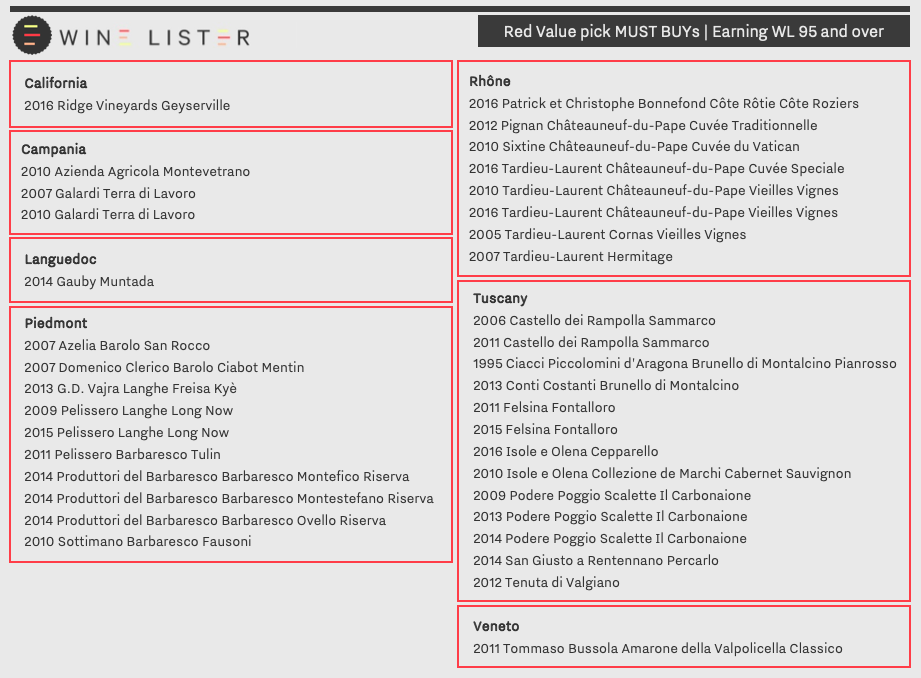
Of the 37 red Value Pick MUST BUYs earning WL 95 and over, a substantial 27 wines hail from Italy, suggesting the impressive quality-to-price ratios offered by many of the country’s producers.
A passion for Piedmont
Famed Piedmont cooperative, Produttori del Barbaresco appears three times on the list, with the 2014 vintages of its Montefico Riserva, Montestafano Riserva, and Ovello Riserva. Despite hailstorms damaging several Barbaresco vineyards in 2014, Produttori’s premium sites are subject to rigorous grape selection, meaning its single-vineyard wines retained quality in the vintage. Achieving the highest score of the three labels from Wine Lister partner critic, Antonio Galloni (96) who calls it a “potent, structured Barbaresco”, the Montefico Riserva can be purchased from Hatton & Edwards for £42 per bottle (in-bond).
Tenderness for Tuscany
Moving further south, Podere Poggio Scalette’s Il Carbonaione is represented by its 2009, 2013, and 2014 vintages, which all achieve WL scores of 95. With over 10 years of age, the 2009 is described by Wine Lister partner critic, Jancis Robinson, as offering a “very voluptuous, exotic nose”, with notes of “both herbs and spices – and some meatiness […] very exciting and bursting with health”. It can be bought from Atlas Fine Wines for £33 per bottle (in-bond).
A romance with the Rhône
Family-owned, micro-négociant, Tardieu-Laurent represents five of the eight Rhône Value picks, with its 2016 Châteauneuf-du-Pape Cuvée Speciale, 2010 Châteauneuf-du-Pape Vieilles Vignes, 2016 Châteauneuf-du-Pape Vieilles Vignes, 2005 Cornas Vieilles Vignes, and 2007 Hermitage. Despite its small-scale production (a consequence of its meticulous selection process), Tardieu-Laurent offers excellent value across its labels. Jancis Robinson awards 18 points to the 2016 Châteauneuf-du-Pape Vieilles Vignes, noting it is “very aromatic and then so sweet and round on the palate! You want to gobble it up immediately”. It can be purchased by the case of 12 from Tardieu-Laurent’s exclusive UK agent, Corney & Barrow for £390 (in-bond).
Caring for California
Representing the New World, Ridge Vineyards’ Geyserville appears in the line-up with its 2016 vintage. A single-site blend of 73% Zinfandel, 17% Carignan, 7% Petite Syrah, and 3% Alicante Bouschet, it achieves a WL score of 95, and is described by Antonio Galloni as offering “black cherry, graphite, lavender, and spice”, with “a purity […] that is absolutely striking”. Also noted by Jancis Robinson as having “snug, focused aromatics with hints of floral lift” and “a palate bursting with flavour”, the 2016 Geyserville can be acquired by the bottle from Lay & Wheeler for £33 (in-bond).
As 2020 draws to a close, Wine Lister has compiled a report celebrating the top-performing wines and producers within a series of categories over the past year. Using our axes of Quality, Brand, and Economics, and the several factors that constitute these values, we have created seven leagues that paint a panoramic view of some of the world’s best wines, ranked within their areas of excellence.
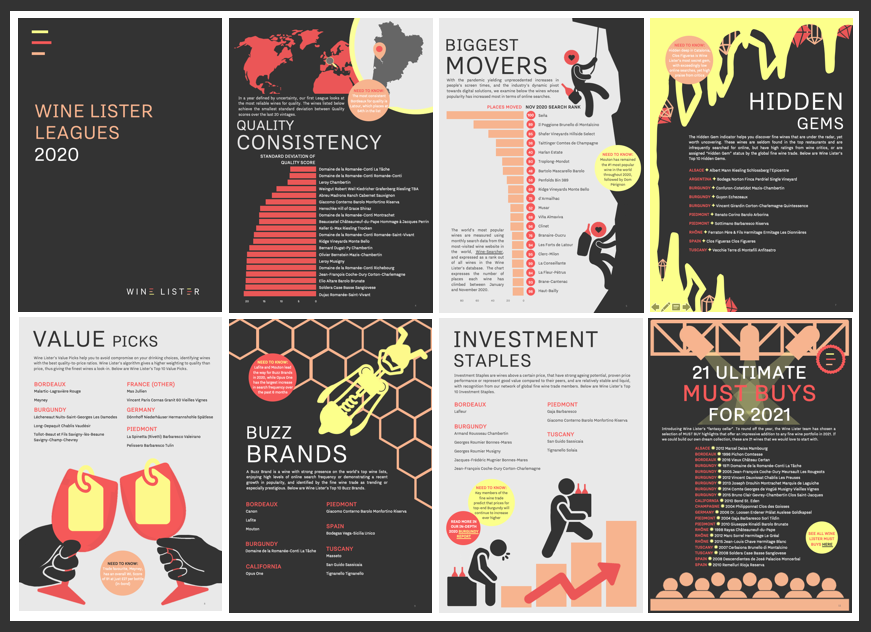
Wine Lister’s 2020 Leagues include rankings of Quality Consistency (wines that show the smallest standard deviation between Quality scores over the last 20 vintages), and Biggest Movers (wines whose popularity has increased most in terms of online searches over the past year). Our team has also put together its top-10 wines per Wine Lister Indicator, revealing our recommendations for Hidden Gems, Value Picks, Buzz Brands, and Investment Staples.
We end the Leagues with a list of 21 Ultimate MUST BUYs for 2021, compiling a selection of MUST BUY highlights hand-picked by our fine wine experts, that offer an impressive addition to any fine wine portfolio in 2021. These are some of the picks that would feature in Wine Lister’s “fantasy cellar”.
Download your free copy of Wine Lister’s 2020 Leagues here.
Top chefs are often interrogated on their favourite dishes to cook at home, actors on their favourite films, writers on their favourite books – Wine Lister has sought out the ultimate drinking inspiration for special occasions, interviewing a handful of top wine producers on their favourite wines.
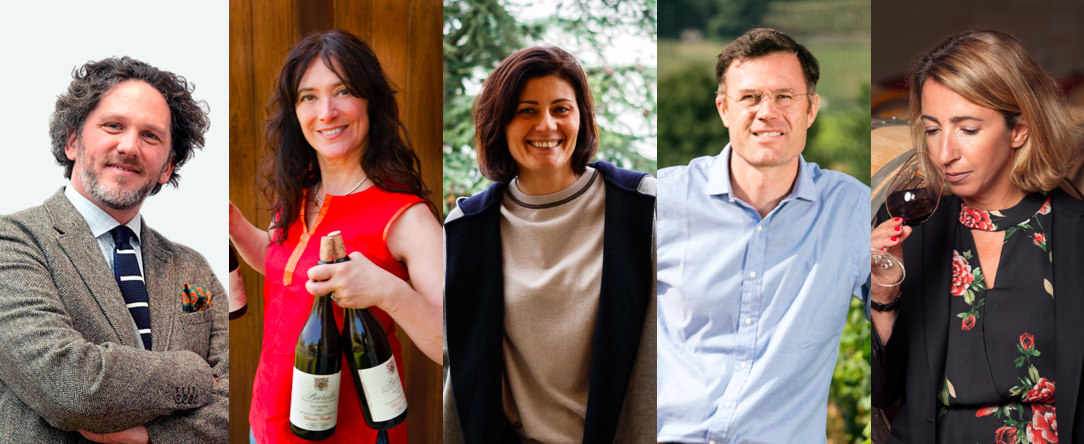 From left to right: Axel Heinz, Chiara Boschis, Gaia Gaja, Jacques Devauges, and Marielle Cazaux
From left to right: Axel Heinz, Chiara Boschis, Gaia Gaja, Jacques Devauges, and Marielle Cazaux
Axel Heinz – Ornellaia
“It’s certainly the most difficult question to answer for a winemaker”, Axel begins. Born in Germany, and spending his early career in Bordeaux before joining Ornellaia, his choice, once we twisted his arm, sits far from his professional vinous journey. “It would be a white, from my favourite Grand Cru in Burgundy: Corton Charlemagne”, he confesses, explaining that for him, these wines combine the structure and power of a red wine, with “the vibrancy, fragrance, and minerality that one can only find in great whites”. Admiring its capacity for a faithful expression of terroir, and display of true personal signature, he cites Coche-Dury as his go-to producer.
Chiara Boschis – E.Pira e Figli
With Barolo in her blood (her relatives founded the historic Giacomo Borgogno estate), it is not unusual that Chiara Boschis’ favourite wine should hail from this same noble Italian region. She tells us that she understood from a young age “the privilege to be born in such a generous land”, for which her parents, and the people around her had “great love and respect”. After years in the cellar at E.Pira, she too became “entirely captured by the magic of Barolo”. Chiara’s top choice is therefore a Barolo from the Mosconi vineyard for its “complexity and depth”, Cannubi for its “elegance”, and the vineyards of Via Nuova for their “diversity”.
Gaia Gaja – Gaja
While paying homage to her family’s past through her own wines, fifth generation winemaker, Gaia Gaja also has one eye on the future. Her favourite wine, from rising star appellation Mount Etna, Sicily, is Graci’s Etna Rosso Arcuria. The wine is made from one of the latest ripening European varieties, Nerello Mascalese, in one of the highest vineyards in Europe. She discovered it after “becoming close friends with Alberto Graci and his family”, often visiting them in Etna. Gaia explains that “the contrasts between its vibrancy, freshness, and warmth, as well as its perfume and smoky minerality”, remind her of “the snow and the fire of Etna”. Comparing it to Nebbiolo, she believes the grape has “intriguing personality, a strong identity of place, and a medium body that makes it versatile and easy to drink”.
Jacques Devauges – Clos des Lambrays
Moving from Clos de Tart to Clos des Lambrays last year, Jacques Devauges’ top wine of all-time was born close to home. He tells us that Comte Georges de Vogüé’s Musigny catalysed his passion for wine. Sampling the 1971 and 1978 as a teenager, he was “struck” by both, despite knowing very little about wine at that point. Jacques believes Vogüé’s Musigny shows “the signature of the Grand Vin”, to impress “not only the wine geek, or the collector, but everyone, even those who don’t know what makes a good wine”. Describing what “was almost a shock”, he notes that the “level of perfume on the nose was almost like a perfume you can put on your skin”, while the palate was “soft and delicate”.
Marielle Cazaux – La Conseillante
Joining La Conseillante from neighbouring Petit-Village in 2015, Marielle Cazaux tells us that if she had to pick a favourite wine, it would be Ridge Vineyards Monte Bello, because she “has so many special memories with this wine”. As an intern at Ridge in 2001, she had the chance to taste several vintages with the legendary Paul Draper, whom she calls “one of the most gifted winemakers of the US”. Marielle considers Monte Bello a “wine with extraordinary finesse”, and “a total sense of harmony”. Describing its notes of “black pepper, lavender, mocha, liquorice, and dried flowers”, she observes that it is “perhaps one of the most “Bordeaux” style wines in California”.
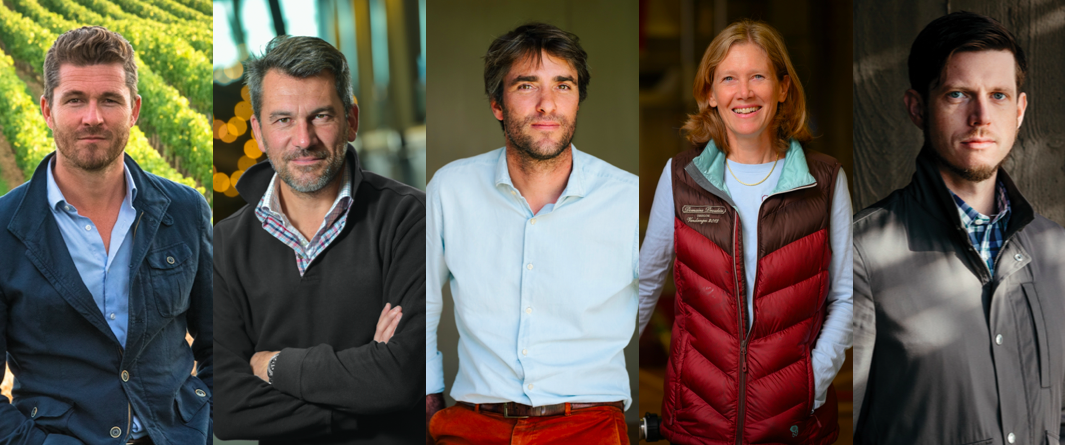 From left, Nicolas Audebert, Nicolas Glumineau, Pierre-Olivier Clouet, Veronique Boss Drouhin, and Will Harlan
From left, Nicolas Audebert, Nicolas Glumineau, Pierre-Olivier Clouet, Veronique Boss Drouhin, and Will Harlan
Nicolas Audebert – Rauzan-Ségla, Canon, and Berliquet
With some of the world’s most prestigious wineries under his belt (Terrazas de Los Andes, Cheval des Andes, Moët & Chandon, Krug, Veuve Clicquot), Nicolas echoes Axel Heinz in attempting to pick his favourite wine: “it’s impossible to answer. It’s like music – endless, initiatory, and progressive”. He instead recommends a wine from his friend, winemaker Andrea Felluga, with whom he “shares wine at simple, festive tables with lots of laughter”. He tells Wine Lister that Felluga’s wine, Livio Felluga Terre Alte “is a great white from Friuli” – a “land of contrast between the sunny and singing soul of Italy and the Alpine foothills, austere and cool”. Made from a blend of Friulano, Sauvignon Blanc, and Pinot Blanc, the Terre Alte is, according to Nicolas, like Felluga – “happy and lively”.
Nicolas Glumineau – Pichon Comtesse
On the subject of his favourite wine, Nicolas Glumineau (previously of Haut-Brion, Margaux, and Montrose), tells us that there are so many wines he could note – “Rayas 1990, E. Guigal La Mouline 1976, Cristal 1996, Trotanoy 2009, Diamond Creek Red Rock Terrace 2015”. White Burgundy legend, Coche-Dury, nonetheless gets another vote from Nicolas (on top of praise from Axel Heinz) as he reminisces trying the Meursault Caillerets 2006 for the first time in London, and being “choked, speechless, and moved by such perfection”. He describes the “delicacy of its white flower aromas and the elegance of its mineral and endless finish”, and recalls the feeling “that the world has stopped turning and that time has been suspended”.
Pierre-Olivier Clouet – Cheval Blanc
Echoing the sentiment of several of his peers, Pierre-Olivier Clouet (who has been at Cheval Blanc for 16 years), tells us that “it is impossible to choose just one wine”, because “like wine, the palate of the taster is constantly evolving”. Pierre-Olivier nonetheless notes his current favourite is “Mas Jullien – a wine that fully expresses the identity of the place where it is made, and injects the touch of balance and freshness that characterises all the great wines of the world”. He recalls that the last time he tasted the Languedoc red – a blend of Syrah, Carignan, and Mourvèdre – was with his team, on the last day of Cheval Blanc’s 2020 harvest.
Veronique Boss Drouhin – Joseph Drouhin
Fourth-generation winemaker, Veronique Boss Drouhin tells us that a wine she particularly enjoys was introduced to her by her close friend, Christine Vernay, daughter of the late Georges Vernay (praised for his key role in the survival of the Condrieu appellation). Veronique recalls Vernay opening a bottle of Georges Vernay Condrieu Coteau de Vernon, and being enchanted by its “aromatics, jumping out of the glass – unique, fragrant, and complex”, and a palate that was “powerful, voluptuous, and round, but with acidity to balance it” – a rarity for Viognier. She also cites Georges & Christophe Roumier’s Chambolle-Musigny Les Amoureuses as one of her favourites, adding, “Christophe’s [wine] is one of the nicest, purest, more elegant expressions of Pinot”.
Will Harlan – Promontory
Leading Harlan Estates‘ second-generation venture, Will Harlan explains to us that while he cannot choose a favourite, Jacques-Frederic Mugnier’s Musigny 2001 is a wine that he believes to “belong among the finest”. Will recalls coming across the bottle while “travelling with colleagues through Copenhagen a few years ago”, and as there hadn’t been a correct time to open it, the bottle joined them “on a course through Germany to Switzerland”. Having finally found an appropriate evening in Zurich to open it, “by the lake — the first bit of rest since the trip began”, he was “drawn in, as each feature of the wine, with a humble nobility, felt very naturally and confidently in its place”. Will notes it was a “wine that was singular and true”, that “would mark a memorable evening of our travels and in our friendships”.
As much of Europe re-enters lockdown, the fine wine industry is once again adapting through the digital world. With many reliable retailers now running e-commerce platforms, there is simply no excuse not to purchase top-quality wine from the comfort of your own home. To help you get the best from your online buys, Wine Lister offers its top tips on avoiding compromise on your acquisitions, whether for drinking or for laying down in the cellar.
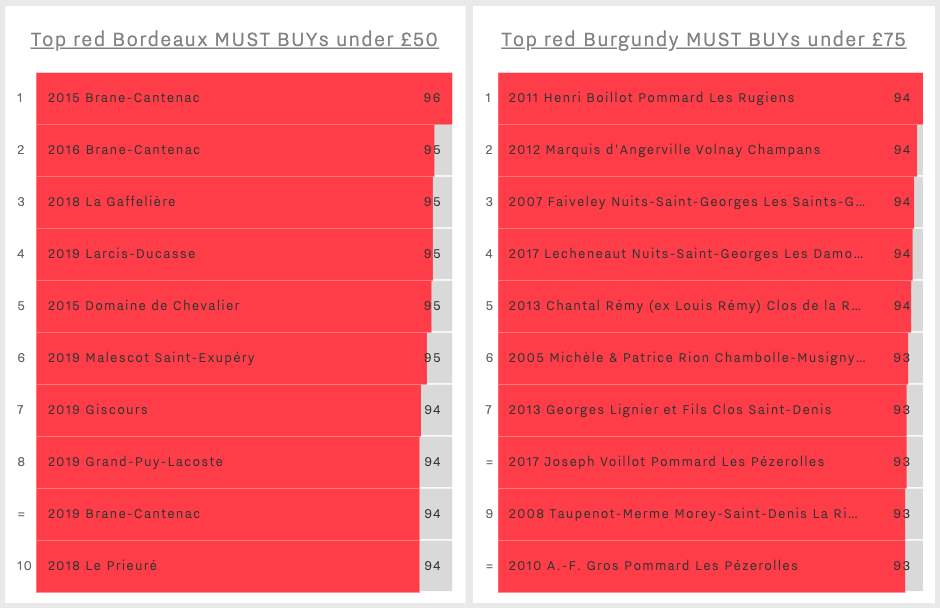
- Narrow down your drinking delights
With a plethora of brilliant bottles now available to purchase online, Wine Lister’s free tools provide a good place to start your decision journey, helping you to refine your browsing before you even begin. On top of our MUST BUY recommendation algorithm, our Wine Leagues provide top-10 lists of the best wines to source for given categories, be it appellation, price, or WL score (a quality measure comprising ratings from Wine Lister’s partner critics). Featured on the individual wine pages, Wine Lister’s drinking windows inform you of the best time to open your bottle, another key factor to consider when buying wine. The above sets of Wine Leagues reveal the top Bordeaux reds for under £50 (per bottle in-bond) and the top Burgundy reds for under £75.
- Elect an esteemed merchant
Whether you have determined what you want or not, it is crucial to buy only from trusted merchants. While pricing may vary, Wine Lister recommends sticking with reputable retailers to ensure top-notch provenance and delivery. The list of legitimate options is long, but we suggest the following (to name but a few): Berry Bros & Rudd, BI Fine Wines, Corney & Barrow, Goedhuis & Co, Justerini & Brooks, Lay & Wheeler, and Vinum Fine Wines.
- Refine through regional specialists
If your focus is on one region in particular, it can be beneficial to buy from specialist merchants. For example, Stannary Wines represent several top Burgundy producers, and Armit Wines are the agent for a number of leading Italian estates, providing dependable platforms for you to direct your search. It is useful to know which merchants are the primary UK importers of specific domains, for example, Justerini & Brooks represent Philipponnat Clos des Goisses, and Four Corners work with many top Californian fine wines.
For more industry insights and advice on which wines and regions to buy, sign up for Wine Lister’s free newsletter here.
Releases from two cult Californian producers have taken centre stage this week so far – see the analysis below.
Vérité 2017s
The 2017 vintage of the Vérité trio – La Muse, Le Désir, and La Joie – was released on Monday, at £320 per bottle each (in-bond). The latest releases have picked up much praise from critics, and mark an historic year for the estate – completing its harvest one week before the arrival of North California’s devastating Tubbs Fire, Vérité’s vineyards escaped unscathed, and their grapes picked before any smoke taint from neighbouring areas could set in. This also marks the first collective release of Vérité’s flagship wines in an assorted case, with previous vintages available to purchase separately.
Comprising 100% Merlot grapes for the first time since its conception, La Muse 2017 receives 96 points from Wine Lister partner critic, Antonio Galloni. He notes that the vintage “is aromatically deep, beautifully persistent and just impeccable in its balance”, stating that he “liked it more than the 2016”. A price of £320 places the 2017 20% below the current market price of the 2016, which has risen over 30% in price since its release, and has limited remaining market availability.
Le Désir 2017 obtains 98 points from Galloni – its highest ever score from the critic. He states it is “off the charts fabulous”, and describes notes of “mocha, chocolate, licorice, leather, menthol, pine and spice”. Akin to La Muse, market availability of last year’s release is scarce, illustrating its good track record of selling through post-release. Keeping in mind the 2017’s record-breaking score, it will be interesting to see if this trend continues this year, given the collective format in which the wines are being sold.
La Joie 2017 breaks the same record as its sibling, Le Désir, receiving its highest score to date from Galloni (96). He calls it “another gorgeous wine in this lineup”, describing “hints of rose petal, lavender, mint and blood orange”, and concluding that it is “a stunning wine by any measure”.
Joseph Phelps
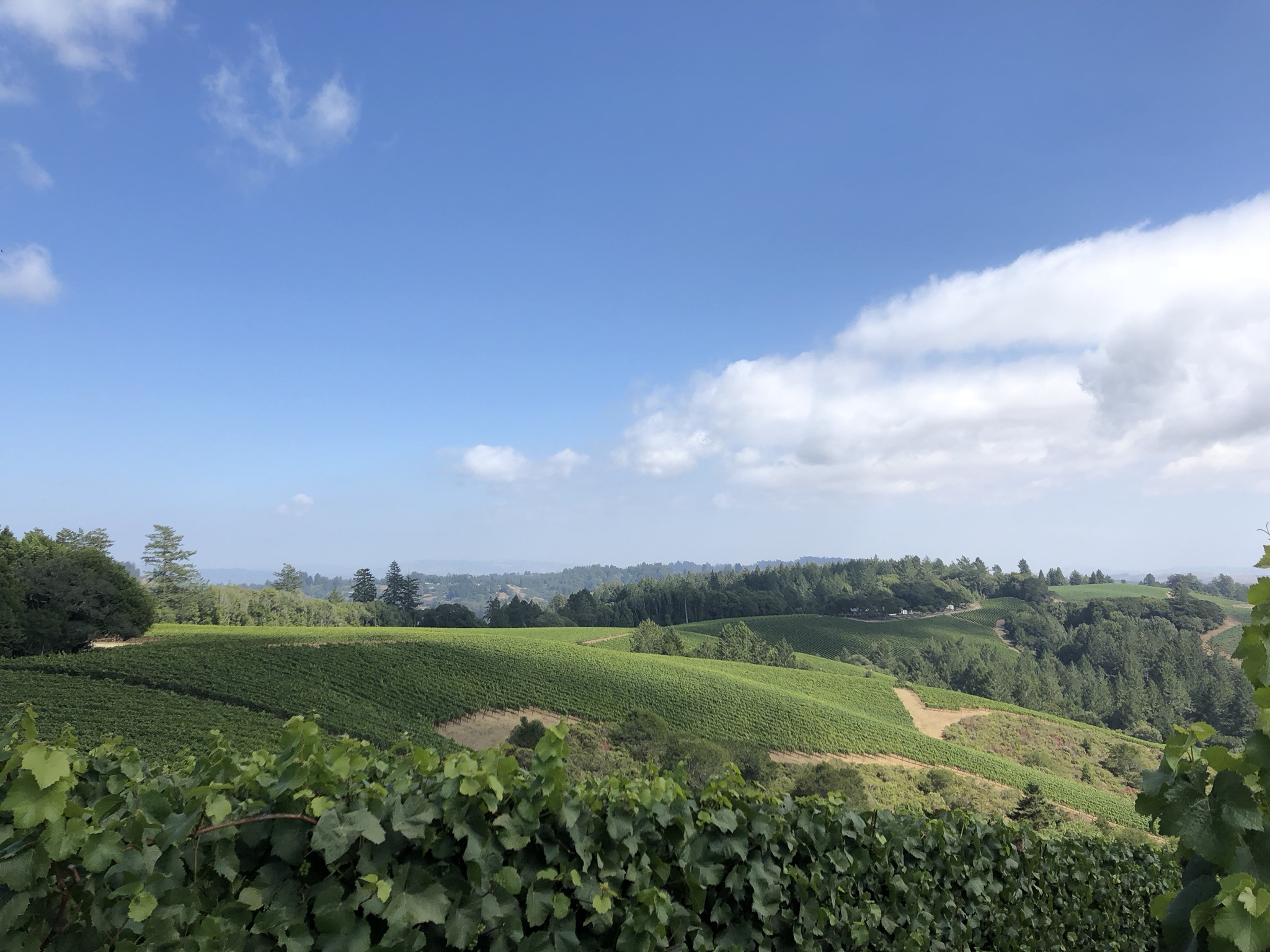 Joseph Phelps’ Napa Valley vineyards – which saw their hottest recorded temperatures in 2017
Joseph Phelps’ Napa Valley vineyards – which saw their hottest recorded temperatures in 2017
Insignia 2017 entered the market yesterday at £160 per bottle in-bond (flat on the 2016 release price). As we were told in a recent Zoom tasting with Phelps’ granddaughter and the winery’s Director of Business Development, Elizabeth Neuman, the 2017 vintage lives up to her vision of Insignia as “a tangible legacy of Joe himself – achieving the best of the best”. Neuman informed us of Winemaker, Ashley Hepworth’s recent dedication to achieving texture in the wine, through which she has experimented with blending trials prior to ageing.
Awarding Insignia 2017 91-94 points, Galloni indeed describes a “dark, sumptuous and enveloping feel, with a real sense of breadth and textural resonance”, adding that “more than anything else, the 2017 is all about palate richness”. Wine Lister likewise recognised the finessed texture of the vintage, with Wine Lister CEO, Ella Lister, calling it “supple, gentle, and silky” on the palate, complete with “dark fruit, plum, and chocolate” on the nose.
Frequent heatwaves in 2017 saw record-high temperatures reached throughout the growing season, including an instance of 46.7°C, recorded in Phelps’ Saint Helena Ranch during Labor Day weekend. The 2017 vintage is consequentially the winery’s smallest in 20 years, with total production down 60% on the 2016. The significant reduction in the volume released this year, as well as the estate’s developing style, may work to encourage interest.
Also released over the past two days: Orma 2018, Petrolo Galatrona 2018, and Siepi 2018.
Sign up to Wine Lister’s free subscription to get market insights delivered straight to your inbox: https://wine-lister.com/subscribe/info.
Sampled by the Wine Lister team at last week’s CVBG Beyond Bordeaux tasting, the latest Place de Bordeaux releases cover a range of regions and price points. Below we examine some of the highlights:
Wednesday 9th September
Released at c.£225 per bottle (in-bond), Beaucastel Hommage à Jacques Perrin 2018 enters the market below the current prices of the two previous vintages (see graph below). Hommage was a Wine Lister favourite this year. We detected bright, candied strawberries, orange skin, and clove, while its mouthfeel offered a momentary grip of tannins, followed by a silky-smooth finish.
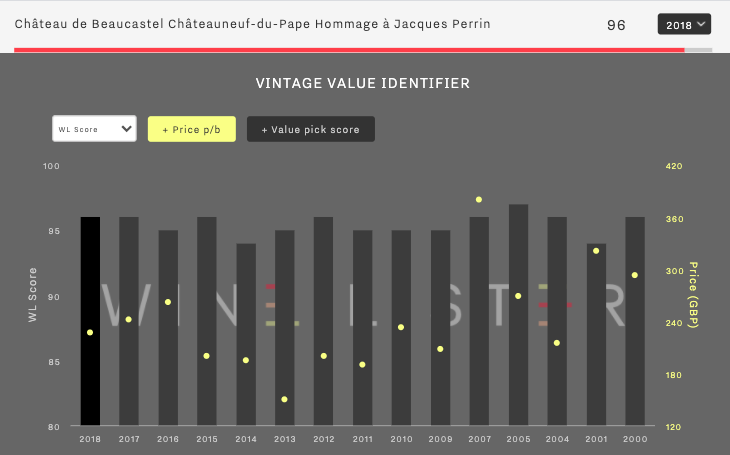
With a 15% reduction in volume released this year, alongside the château’s unwavering reputation for producing benchmark quality in Châteauneuf-du-Pape, the new vintage is worth considering for future drinking. In the meantime, back vintages 2015, 2012, and 2009 also look good in terms of price and quality. Writing for JancisRobinson.com, Tom Parker MW awards the 2018 17+ points, noting “meaty, earthy fruit on the nose, very complex already”, and “damson and morello cherry” on the palette.
Inglenook Rubicon 2017 also entered the market on Wednesday at £120 per bottle (in-bond). Produced by the estate since 1978, the flagship wine has maintained a score of 95 or above from Wine Lister partner critic, Antonio Galloni, over the past five vintages, and the latest release is no exception. Awarding it 95 points, he describes notes of “red fruit, cedar, sweet pipe tobacco, menthol and licorice” that “all develop in the glass”. Our team detected complex spice and oak, softened by a gentle hint of vanilla.
Thursday 10th September
Released yesterday at £54 per bottle (in-bond), Cheval des Andes 2017 receives 17.5+ points from Tom Parker MW for JancisRobinson.com. He describes “intense and expansive black fruit and spices on the nose, with a hint of black olive and violet”, and “blueberry, violet and dried herbs” on the palette. He concludes, “I expect this to become even more impressive after 5 years in bottle, though you could drink it sooner”. Having tasted a flight of recent back vintages at the time of last year’s release with Technical Director, Gérald Gabillet, the Wine Lister team can attest to Cheval des Andes‘ continued upward quality trajectory. We noted a definite complexity within the latest vintage, which offers a nose of Parma violets, white pepper, and bright berries. Cheval des Andes 2017 enters the market under current prices of the last three vintages, and is worth snapping up if there remains any availability.
Solaia 2017 completes the quartet of releases from the past couple of days. Matching last year’s release price of £175 per bottle (in-bond), the latest vintage comes onto the market comfortably under current prices of the previous two (which have increased their respective values by c.20% since release – see chart below). Wine Lister partner critic, Antonio Galloni, awards Solaia 2017 95+ points, and describes “terrific aromatic expansiveness and tons of persistence”. There is anticipation for this score to improve: “I can’t wait to taste it with a bit more time in bottle”, he adds. We tasted the 2017 last week, and were indeed impressed with its development, finding an elegant nose of violet drops and cocoa powder. Given its impressive quality in such a challenging year, and the wine’s history of good price performance post-release, this is well worth securing now.
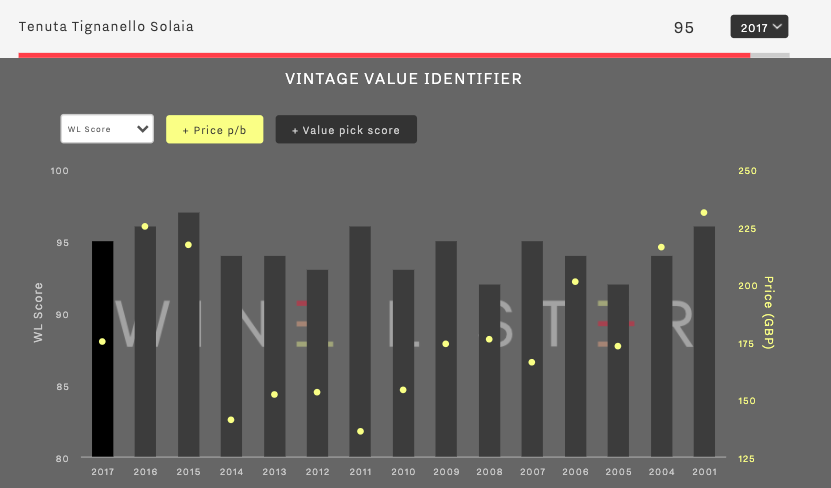
Among other benefits available exclusively to the trade, Wine Lister’s Pro+ Subscription offers real-time release alerts and live analysis on major wine releases throughout the vinous calendar. Please email us at team@wine-lister.com to enquire.
The last two days of Place de Bordeaux releases have included vintages from three powerhouse producers of different regions, whose commonality lies in their use of Bordeaux varietals. Below we examine these key releases.
Monday 7th September
The second week of September Place de Bordeaux releases began with the latest offerings from cult Californian producer, Opus One. Described by Wine Lister partner critic, Antonio Galloni, as “one of the most complete wines of the vintage”, 2017 Opus One was released onto the UK market at £228 per bottle – the same price as the 2016. Awarding it 95+ points, he states that the 2017 is “a dense, full-throttle beauty”, with “a distinctly red-toned fruit profile that distinguishes it from the surrounding vintages”. Although receiving one point less than the 2016 (which has a score of 96+ from Galloni), the latest vintage holds particular significance. 91% of fruit had been picked just before the devastating Californian wildfires commenced, eradicating two lots of Opus One vines. Awarding 17.5 points to the 2017, Wine Lister partner critic, Jancis Robinson, notes that there is “not a trace of smoke taint”, and describes “a combination of savoury and something as sweet and chalky as Edinburgh rock”.
Both the historic nature of the vintage, and the reduction in volume released this year are facts sure to encourage high levels of interest. Opus One is, perhaps unsurprisingly, the number one US wine (and joint-fifth overall) voted by the trade to have seen the sharpest rise in demand, as shown below:
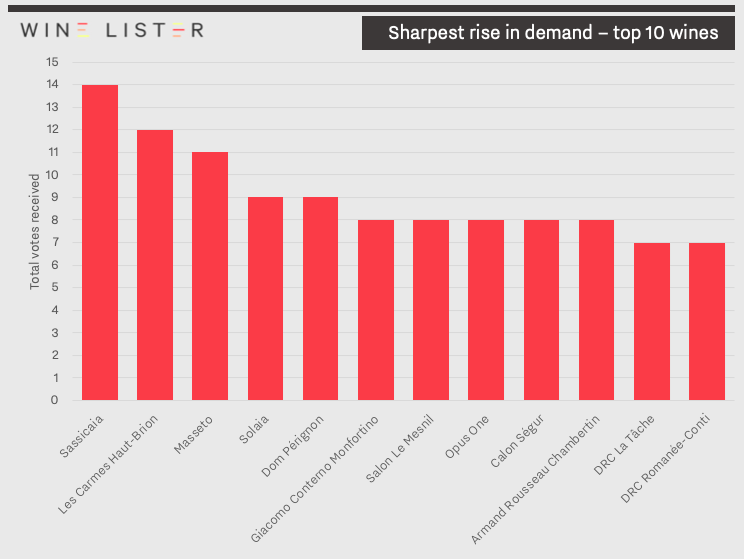 Results from Wine Lister’s 2019 Founding Members survey, showing the consensus on the top 10 wines that have seen the sharpest rise in demand
Results from Wine Lister’s 2019 Founding Members survey, showing the consensus on the top 10 wines that have seen the sharpest rise in demand
Tuesday 8th September
Kicking off yesterday’s releases, Masseto 2017 was released, and merchants were offering at around £480 per bottle. Though slightly higher than last year’s first tranche release price (readers should note that this year, there is only one single tranche), the 2017 enters the market 11% below the current price of the 2016. Antonio Galloni gives the 2017 96-99 points (up from 94-97 for the 2016), calling it a “spectacular wine in the making”, with notes of “red cherry jam, mocha, leather, licorice and a dash of new oak”. While 2017 will be remembered as one of the hottest and driest growing seasons in recent history, Winemaker, Axel Heinz, states that the vintage “managed to encapsulate all the ripeness and concentration” of the climatic conditions. Indeed, Galloni notes that the latest release is “quite simply a remarkable wine for such a challenging year”. Masseto already earns strong acclaim as the wine to have seen the third-sharpest rise in demand according to the trade (see above) – the 15% reduction in volume released onto the market from last year will no doubt only encourage requests for the 2017 further.
The second wine from the cult producer, Massetino 2018 was also released yesterday, at a likely UK market price of c.£205 per bottle. Although its second vintage, this is the first international release of Massetino, as last year’s distribution was limited to the Italian and the US markets only. We sampled the latest release at CVBG’s Beyond Bordeaux tasting, and found it to have expressive, concentrated fruit on the nose, and more refined notes of Marcello cherry and minerality on the palette.
Yesterday’s releases ended with a bang, as Latour released its 2009 vintage. Merchants offering at c.£860 per bottle place the 2009 just under the current market price of the iconic 2010. This is the first ex-château stock to be released since its original en primeur release, and is available at a c.10% premium to existing stock on the market. Wine Lister partner critic, Neal Martin, awards the latest release 99 points, stating that it “is endowed with a simply magnificent nose with intense blackberry and cassis fruit laced with minerals and graphite, extremely focused to the point of overwhelming the sense”. “Wow”, he concludes.
Among other benefits available exclusively to the trade, Wine Lister’s Pro+ Subscription offers real-time release alerts and live analysis on major wine releases throughout the vinous calendar. Please email us at team@wine-lister.com to enquire.
The Place de Bordeaux September releases commenced this week (Tuesday 1st September), launching the distribution of several New World (and a few Old World) icons through its impressive network. The releases have so far exhibited high praise from critics. This affirms the increasing appeal of New World wines, despite the current economic crisis making for an unlucky welcome.
Choices from Chile
Clos Apalta opened the stage on Tuesday, with a vintage that marks its 20th anniversary, as honoured by the 2017’s commemorative bottle. Receiving 100 points from James Suckling, and 95 points from Luis Gutiérrez for Wine Advocate, its average critics’ score of 97.5 matches both the 2016 and 2015 vintages. We sampled it at this week’s Bordeaux and Beyond tasting, organised by négociant CVBG, and found notes of bright red fruit, spice, and orange peel. Despite being one of the most expensive recent vintages (joint with 2016) at £74.50 per bottle (in-bond), Clos Apalta has no doubt achieved a high quality for this anniversary bottle.
Another Chilean entry, Almaviva 2018 was released at £101.00 per bottle (in-bond) on Wednesday (2nd September) – c.4% down on last year. Its average critics’ score of 97 points places it in line with 2017 as the joint-best average score to date, which, alongside its slight reduction in volume from last year, may stimulate demand. Indeed, we found the 2018 to be bright and energetic, with notes of ripe currants, green tomato, and spice.
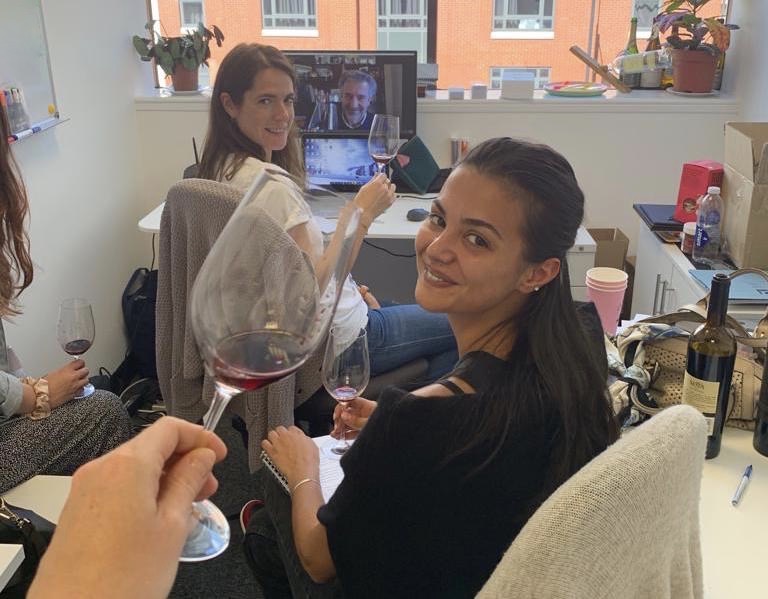 The Wine Lister team sample 2018s from Seña and Chadwick with Owner, Eduardo Chadwick, and his team
The Wine Lister team sample 2018s from Seña and Chadwick with Owner, Eduardo Chadwick, and his team
Released on Thursday (3rd September) at £82.50 per bottle (in-bond), Seña 2018 is “the best vintage of this decade”, according to Owner, Eduardo Chadwick. He explained to us that growing conditions in 2018 were balanced between the two previous vintages (2016 was very cool, while 2017 was hot and dry), creating “almost a perfect season”. The vintage receives 100 points from James Suckling, and 98 points from Luis Gutiérrez for Wine Advocate, making it Seña’s highest-ever average score from those two critics – 99. Our team was equally impressed in our virtual tasting, noting its velvet mouthfeel, silky tannins, and juicy freshness. Chadwick 2018 was also released this week (just 6000 bottles), acquiring an average critics’ score of 97.5 at £226.33 per bottle (in-bond).
Introducing Italy
Bibi Graetz Testamatta 2018 and Bibi Graetz Colore 2018 entered the market on Tuesday (1st September), at £70 and £180 per bottle (in-bond), respectively. Both wines offer significant discounts from their previous releases, and have achieved praise from critics. James Suckling gives 97 points to Testamatta 2018, describing a “cherry and lemon rind character”, and “fine tannins”, and 100 points to Colore 2018, calling it “one of the best vintages ever produced. The high quality and suitable pricing of both wines will likely be embraced in the present economic climate.
An Australian addition
Jim Barry The Armagh Shiraz 2016 entered the market on Wednesday, at c.£151 per bottle (in-bond), marking the producer’s inaugural release through La Place de Bordeaux. The vintage received 97 points from Wine Advocate’s Joe Czerwinski – the highest WA score received by The Armagh Shiraz since its 2012 vintage. He states that the 2016 is “full-bodied and supple” and “finishes cedary, intense and long, adding in complex, lingering spice notes”.
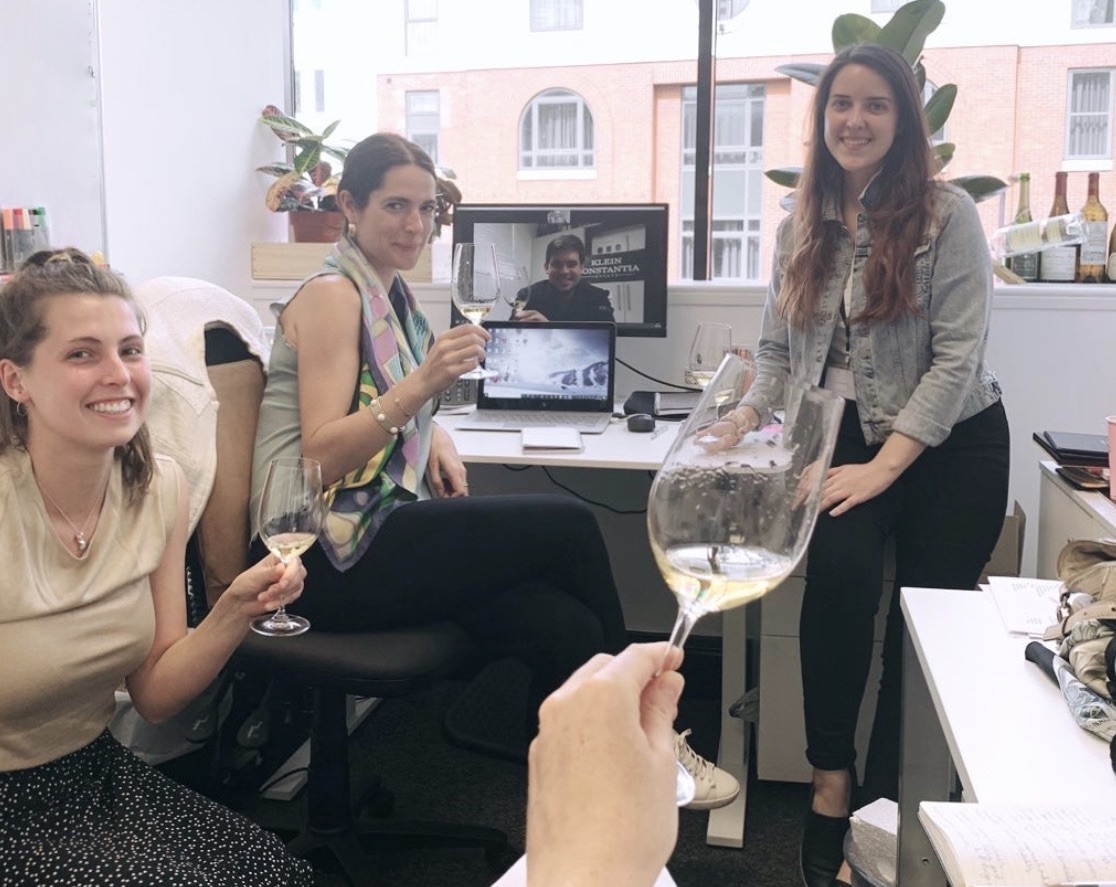 The Wine Lister team sample the 2017 Vin de Constance with Winemaker, Matt Day
The Wine Lister team sample the 2017 Vin de Constance with Winemaker, Matt Day
A sweeter offering from South Africa
As told to us by Winemaker, Matt Day, in a recent Zoom tasting, the 2017 Vin de Constance (released on Wednesday 2nd September) is the closest vintage yet to their philosophy of creating a “dry sweet wine”. Wine Lister’s CEO, Ella Lister, notes hints of “apricots, rosewater, lemon balm, Marcona almonds, and acacia honey” among other aromas, and on the palate “dried apricots and a gorgeous savoury finish”. At £39 per bottle (in-bond), the 2017 receives 97 points from James Suckling, compared to an average of 95 (from James Suckling and Wine Advocate) for each of the past three years. While it does not offer a discount, Klein Constantia does a spectacular job of achieving high quality in its developing style of Vin de Constance.
Kick-starting California
L’Aventure Estate Cuvée 2018 was released yesterday (Thursday 3rd September) at c.£68 per bottle (in-bond) – flat on the 2017 release price, and earning 95 points from Wine Advocate’s Erin Brooks (one down from the 2017). She noted that “the full-bodied palate is incredibly pixelated and silky with very bold freshness and a long, layered finish” and that she “can’t wait to taste this beauty from bottle”. We enjoyed detecting violet, toast, and vanilla on the nose, and were similarly impressed by its velvet mouthfeel.
Among other benefits available exclusively to the trade, Wine Lister’s Pro+ Subscription offers real-time release alerts and live analysis on major wine releases throughout the vinous calendar. Please email us at team@wine-lister.com to enquire.
With September approaching, Wine Lister has begun to anticipate the collection of top fine wine producers from around the world that release their latest vintages through the Place de Bordeaux. Although a region steeped in tradition, the trend for Bordeaux négociants to offer these wines in the first weeks of September suggests a loosening in the division between Old World and New World fine wine production.
To celebrate the impending campaign, this week’s blog examines a small selection of New World wines with longstanding histories:
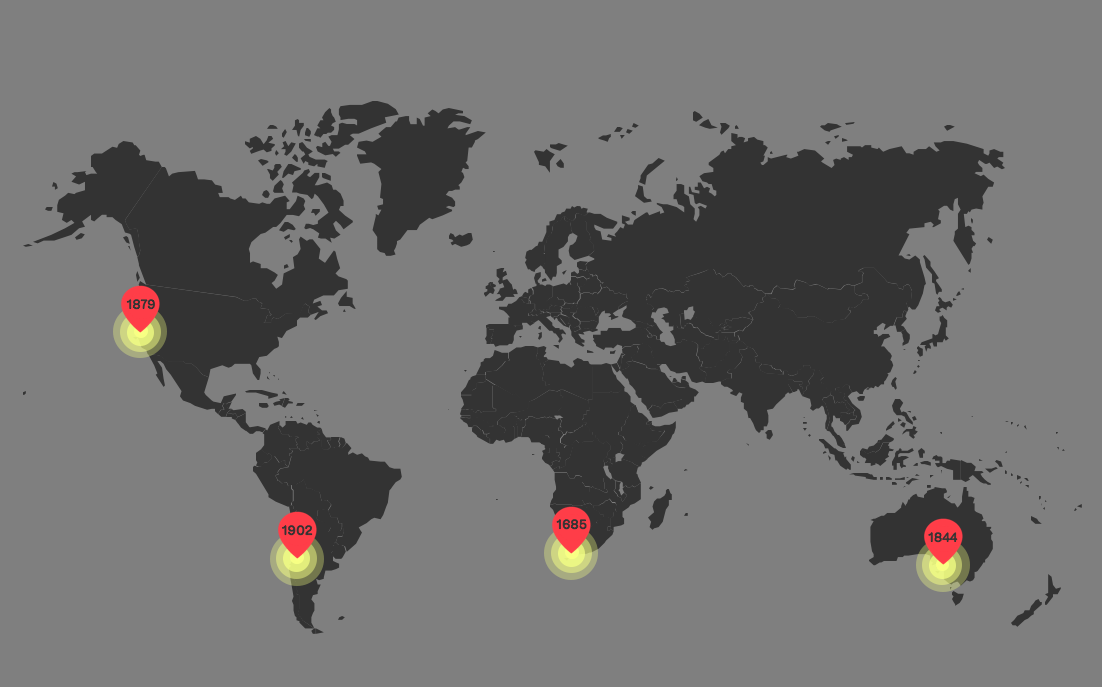 A map of the selected New World wineries: Klein Constantia, Penfolds, Inglenook, and Bodega Catena Zapata
A map of the selected New World wineries: Klein Constantia, Penfolds, Inglenook, and Bodega Catena Zapata
South Africa – Klein Constantia Vin de Constance
Established in 1685 by the first Governor of the Dutch Cape Colony, Simon van der Stel, Klein Constantia was the first commercial wine producer in South Africa. A keen viticulturist, Van der Stel executed extensive research to find the best quality soil in the region, finally deciding on the decomposed granite terroir of the valley he named “Constantia”. Here he planted the first Muscat de Frontignan vines, and commenced the production of Vin de Constance.
In more recent history, Klein Constantia has been elevated over the past decade under Managing Director, Hans Astrom, and Winemaker, Matt Day. Its cellar has been entirely rebuilt, and viticultural practices are now widely organic and biodynamic. The 2017 Vin de Constance is the third vintage produced in the new cellar and will be released through the Place de Bordeaux next month; however, until then, Vin de Constance 2013 achieves a WL score of 94 at c.£71 per bottle (in-bond). It can be purchased by the case of six half-litre bottles from Albany Vintners.
Australia – Penfolds Magill Estate Shiraz
Penfolds was founded by an English doctor, Christopher Penfold, and his wife, Mary, who had transported French vine cuttings on their journey from West Sussex to Australia. After acquiring 500 acres of land in the Adelaide foothills, they commenced production of medicinal tonics, brandies, and fortified wines in the style of sherry and port, to ameliorate the symptoms of Christopher’s patients. As demand for the wines proliferated, production was expanded, and Penfolds was officially established in 1844. The single-vineyard Magill Estate Shiraz is intrinsically linked to the winery’s beginnings, being the only wine grown and made on the original Penfolds property.
With a WL score of 95 at £88 per bottle (in-bond), the 2014 Penfolds Magill Estate Shiraz is a MUST BUY, and was described by Wine Lister partner critic, Jancis Robinson, as “racy and lively”, illustrating “a winemaking tour de force”. It is available to purchase by the case of six from IG Wines.
California – Inglenook Rubicon
Although vines had been planted on the property by its previous owner eight years prior, Napa Valley’s Inglenook estate was officially founded in 1879 by Gustave Niebaum, a Finnish sea captain, fur-trader, and oenophile. With the intention to build a winery to rival Europe’s finest, Niebaum swiftly invested in the development and expansion of Inglenook, purchasing additional land from six neighbours, and commencing construction on the present-day château. Rubicon, the estate’s flagship wine since 1978, is produced from the estate’s best fruit, including Gustave Niebaum’s original Cabernet Sauvignon plantings.
Rubicon typically contains small percentages of other Left Bank Bordeaux varietals, however, the quality of Cabernet Sauvignon in 2013 called for its pure varietal composition. According to Wine Lister partner critic, Antonio Galloni, the 2013 Inglenook Rubicon features “Layers of dark fruit built into a crescendo of aromas, flavors and textures laced with mocha, espresso, gravel and dark spice overtones”. Achieving a WL score of 96, and MUST BUY status, it can be bought by the bottle from Lay & Wheeler for £145.75 (in-bond).
Argentina – Bodega Catena Zapata Nicolás Catena Zapata
Bodega Catena Zapata was founded in 1902 by Italian immigrant Nicola Catena, who planted the initial Malbec vines to produce wine to satisfy the large European immigrant population in Mendoza. As examined in a recent blog post on New World MUST BUYs with rising popularity, Nicola’s grandson, Nicolás Catena Zapata, continued his grandfather’s legacy of establishing of European winemaking techniques in Argentina, through his dedication to high altitude farming, soil studies, and preserving pre-phylloxera Malbec strains.
Its 2017 vintage is due to release through the Place de Bordeaux next month; until then, the 2016 Nicolás Catena Zapata can be acquired by the case of six from Cru World Wine for £278 (in-bond). Comprising 61% Cabernet Sauvignon, 31% Malbec, and 8% Cabernet Franc, the 2016 achieves a WL score of 93, and was described by Jancis Robinson as “very broad, well integrated and welcoming”.
Keep up to date with the September Place de Bordeaux releases through Wine Lister’s twitter.
 From left: Ashley Hepworth, Caroline Frey, and Stéphanie de Boüard-Rivoal
From left: Ashley Hepworth, Caroline Frey, and Stéphanie de Boüard-Rivoal From left: Charlène Pinson, Florence Heresztyn-Mazzini, Eva Fricke, and Donatella Cinelli Colombini
From left: Charlène Pinson, Florence Heresztyn-Mazzini, Eva Fricke, and Donatella Cinelli Colombini










